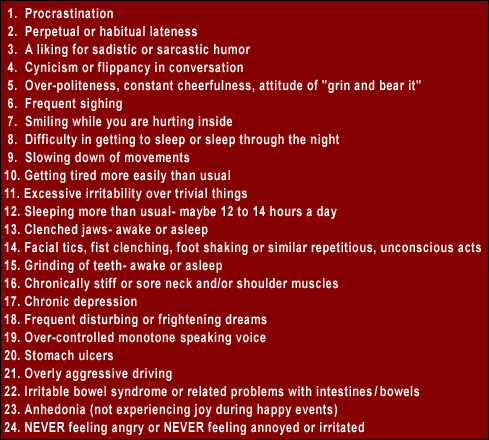
Checklist for Hidden Anger
From a handout of Onsite Workshops (www.onsiteworkshops.com), with additional information from Dr. Gore.
If we have any national fault, it is hiding our own anger from ourselves. Here is a checklist to help you determine if you are hiding your anger from yourself. Any of these is usually a sign of hidden, unexpected anger. If several of these items fit you, you would probably benefit from learning to better acknowledge your feelings.

Hidden anger is not about rage. This is about the feelings we call "irritation," "annoyance," getting mad", etc. All these negative feelings have one thing in common: They are considered undesirable at best, and destructive at worst. We are taught to avoid them if possible (it isn’t) and certainly to avoid expressing them. Unfortunately, many people go overboard in controlling negative feelings: they control not only their expression, but their awareness of them as well.
Because you are unaware of being angry does not mean that you are not angry. It is the anger you are unaware of which can do most damage to you and your relationship with other people. The anger does get expressed, but in inappropriate ways. Freud once likened anger to the smoke in an old-fashioned wood burning stove. The normal avenue for the discharge of smoke is up the flue and out of the chimney. If the normal avenue is blocked, the smoke will leak out of the stove in unintended ways…around the door, through the grate, etc. choking everyone in the room. If all avenues of escape are blocked, the fire goes out and the stove ceases to function. Likewise the normal, human expression of anger is gross physical movement and/or loud vocalization: watch an unhappy baby sometime.
By age five or so we learn that such expressions are unacceptable to others and lead to undesirable consequences, such as being yelled at, beaten or having affection/attention withheld. We learn to "be nice," which means (among other things) hiding "bad" feelings. By adulthood, even verbal expression is curtailed, since a civilized person is expected to be "civil." Thus, expression is stifled, and to protect ourselves from the unbearable burden on continually unexpressed "bad" feelings, we go to the next step and convince ourselves that we are not angry, even when we are. Such self-deception is never completely successful, however–the blocked anger leaks out in inappropriate ways, some of which are listed above.
The items in the list are all danger signals that negative feelings are being bottled up inside. It is true that each of them can have causes other than anger (procrastination, for example, can be due to an extreme fear of failure), but the presence of any of them is reason enough for you to look within yourself for buried resentments. If you are human, you will find some. If you are fortunate, you will find few, since you learned effective ways of discharging them. If you are like most of us, you will need to unlearn old habits before you can learn new ways of handling "bad" feelings–new "constructive" ways, rather than the old "destructive" ways.
Getting rid of a lifetime accumulation of buried resentments is a major task, which can be one of the goals of psychotherapy. Whether such a process is necessary is for you to decide in consultation with a qualified professional. At a minimum, you should learn techniques which will help you to stop adding to the "pile," no matter the existing depth of the "pile."
The process of dealing with perceived "negative" feelings can be divided into three parts for purposes of discussion:
1) Recognizing the feeling. Labeling it. Embracing it.
2) Owning it- acknowledging that it is yours.
3) Discharging it- acting on it in a positive, healthy way.
These three steps are greatly intertwined. If you do them enough, your pile will get smaller. Stay with it and your children will have smaller piles, too
